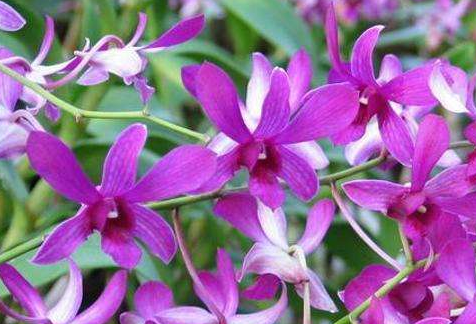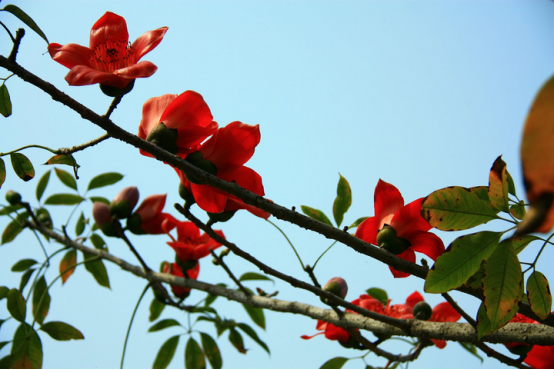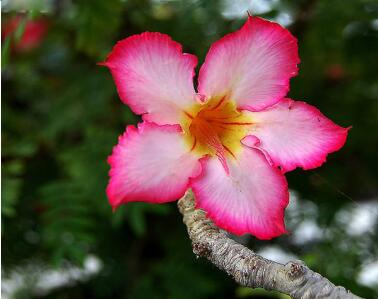Dendrobium planting method
Ramet propagation
Select the dense growing plant, take it out of the basin, cut off the old root, then cut it from the base of the stem, cut the root system as little as possible, cut the connected root-like part, and pull it open by hand. With the main plant as the main plant and then pruning the old root, the new bud can be cultivated into a new plant in a rice basin.

Cuttage propagation
Cutting propagation can be carried out when changing pots after flowering, and it is better to cut from April to August. Stone orchid has a slender, fleshy stem, there are many nodes on the stem, and the nodes can grow buds, so it can be propagated by cutting.
First of all, select uncivilized branches to do sowing, cut into several segments, each section should have two or three sections. Insert the stem into a mixture of moss and peat, exposing it outside and keeping it moist. One week after cutting, there is no tax, but it can be sprayed and moisturized. After one month, new buds grow in the node, and two or three new roots grow out to form new plants.
Cultivation methods of Dendrobium
Dendrobium is an epiphytic orchid of the genus Dendrobium, which is one of the orchids, mainly distributed in Australia and Pacific islands. Dendrobium can be used as medicine, so it has a certain economic value. If you also want or have planted Dendrobium, you can learn the key points of Dendrobium cultivation with Xiaobian.
Dendrobium
During the maintenance period, the light should be sufficient and direct light can be accepted in winter. It can not block the light or cover about 20% of the sun when cultivated in the northern greenhouse in winter. And pay attention to ventilation during maintenance. Dendrobium likes high temperature and high humidity, the temperature of evergreen species should not be lower than 15 ℃ during maintenance, and the species of deciduous leaves can be slightly lower. The temperature difference between day and night is too small, which is not conducive to the growth of Dendrobium, the best range of temperature difference between day and night is 10Mel 15 ℃. Dendrobium requires high air humidity, keeping moist in the basin is the best state, and water can not be accumulated in the basin during the vigorous growth period, otherwise it is perishable. Can often spray water to the surrounding ground to improve air humidity.
In the process of maintaining Dendrobium, we should also strengthen the use of fertilizer, do not apply concentrated fertilizer to Dendrobium, adjust the ratio of nitrogen, phosphorus and potassium according to the growth period, spray or irrigate the root, usually once a week. When changing the basin, the ramet can be carried out at the same time, and after changing the basin, it should be placed in a semi-shady place to control watering, foliar spraying can be carried out properly, and the watering and light intensity should be gradually increased and fertilized after 1 to 2 weeks.
Cultivation methods of Dendrobium
Potted Dendrobium needs light, well-drained and breathable substrates such as peat moss, fern root, bark and charcoal. At the same time, there are many tiles or broken bricks at the bottom of the basin to facilitate the development of root system. The cultivation place must have sufficient light, which is more beneficial to the growth and flowering of Dendrobium. During the growing period of spring and summer, it should be fully watered to speed up the growth of pseudocorm. Gradually reduce watering after September, so that the pseudo-corm tends to mature, which can promote flowering.
During the growing period, fertilization was applied once every ten days, and decreased in autumn, but stopped completely in the mature stage of pseudocorm and winter dormancy period. The plants of Dendrobium which have been cultivated for more than 2 or 3 years are crowded, the roots are full, and the potted materials have rotted, so they should be replaced in time. No matter evergreen or deciduous Dendrobium, change the pot after flowering. When changing the basin, you should hurt the roots less, otherwise the leaves will yellowed and fall off in case of low temperature.
Reproduction method
Ramet, cuttage and tissue culture are commonly used.
① ramet propagation
The combination of changing pots in spring. The mother plant with dense growth will be held out from the basin, the roots and leaves will be less hurt, the orchid seedlings will be gently broken, and 3-4 plants will be planted in 15cm pots, which is beneficial to shaping and flowering.
② cuttage propagation
Select the false bulb that grows and enrich without flowering, cut it from the rhizosphere, cut it into every 2-3 segments, insert it directly into the peat moss or wrap the base of the cuttings with water moss, keep it moist, take root at room temperature at 18-22 ℃, and take root at 30-40 days after insertion. Potted plants with roots 3 to 5 cm long.
Tissue culture and propagation of ③
The shoot and leaf tips were often used as explants, and the differentiation rate could reach about 1:10 on the MS medium supplemented with 2-benzylaminopurine 0.5 mg / L and 6-benzylaminoadenine 0.5 mg / L. The differentiated buds were transformed into active buds.
Charcoal. The MS medium of coconut milk (supplemented with 0.1mg / L of 2 ~ (mae) 4FLY D and 0.1mg / L 6-benzylaminoadenine) could grow normally and form rootless seedlings. When the seedlings were transferred into MS medium containing indolebutyric acid 0.2 mg / L, rooting could be induced and complete plantlets with roots, stems and leaves could be formed.
Pest control
Often have black spot disease, virus disease harm, can use 10% antibacterial agent 401 acetic acid solution 1000 times liquid spray. Insect pests are harmful to shell insects and are sprayed with 2000 times of omethoate EC.
Prevention and control methods:
First, clean Orchid Garden: a small number of diseased leaves in the Orchid Garden should be cut off, and the fallen leaves during the winter disease period should be collected and burned.
Second, greenhouse environmental management: the temperature in the greenhouse is often as high as 40 ℃ in summer, which should be ventilated and cooled to avoid poor growth of orchid plants. During the low temperature period in winter, the water supply should be sunny and sunny at noon, and some plastic sheets should be opened to increase ventilation in order to reduce indoor relative humidity.
- Prev

three。 Culture methods of kapok
1. Seed collection and treatment kapok fruit is grayish black when it is ripe, and the seeds of flowers can easily float around with cotton wool, so if you want to collect seeds in time, spread out and expose the seeds after harvest. A thousand seeds weigh about 47.5 grams and the germination rate is between 70% and 80%.
- Next

A solution to the yellow leaf problem.
1, to the desert rose pouring the right amount of water desert rose leaves yellow fall off, not only a factor in the role, many factors may cause the desert rose leaves yellow fall off. Desert roses prefer dry environments to wet ones. Don't water desert roses too much
Related
- Fuxing push coffee new agricultural production and marketing class: lack of small-scale processing plants
- Jujube rice field leisure farm deep ploughing Yilan for five years to create a space for organic food and play
- Nongyu Farm-A trial of organic papaya for brave women with advanced technology
- Four points for attention in the prevention and control of diseases and insect pests of edible fungi
- How to add nutrient solution to Edible Fungi
- Is there any good way to control edible fungus mites?
- Open Inoculation Technology of Edible Fungi
- Is there any clever way to use fertilizer for edible fungus in winter?
- What agents are used to kill the pathogens of edible fungi in the mushroom shed?
- Rapid drying of Edible Fungi

